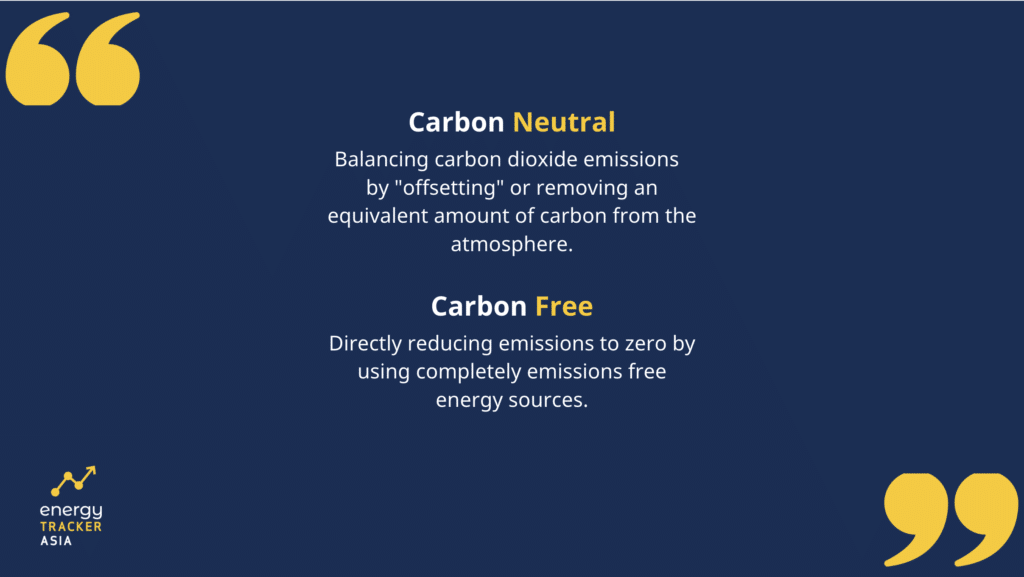Carbon Neutral vs Carbon Free: What’s The Difference?
20 April 2022 – by Eric Koons
The main difference between carbon-neutral and carbon-free is the existence of carbon emissions. Carbon-neutral is an equilibrium by which carbon emissions are equal to carbon reduction so that overall, net-zero carbon enters the atmosphere. On the other hand, carbon-free means no carbon emissions are being produced in the first place.
Let us take a deeper look at both.
What is Carbon Neutral?
Being carbon-neutral means balancing greenhouse gas emissions (GHG) by “offsetting” or removing an equivalent amount of carbon from the atmosphere.
How to Become Carbon Neutral?
One of the most common methods for becoming carbon neutral is through buying carbon credits. A carbon credit is a permit that allows the owner to emit one tonne of carbon dioxide or greenhouse gas emissions. A credit represents another plot of land where one tonne of carbon dioxide is removed from the atmosphere. This is often achieved through planting trees or protecting natural ecosystems from development.
Although it is an essential step in holistic climate action, a commitment to carbon neutrality does not require a commitment to reduce overall GHG emissions. A carbon-neutral business needs only to offset the GHG emissions – even if those emissions are increasing.

What Does Carbon Free Mean?
In contrast to carbon-neutral, becoming carbon-free means directly reducing emissions to zero. For example, if a country or company is carbon-free, all the energy and electricity comes from renewable sources, like wind or solar.
Realistically, carbon-free is much more challenging to achieve than being carbon-neutral. That being said, many countries are making commitments to have carbon-free energy systems in the coming decades. Four states (Washington, California, New Mexico, and Hawaii) have targets that require 100% clean or renewable electricity by a specific year in the US. In other words, they have plans to become carbon-free.
Is Going Carbon Neutral Good?
While most of the world is making carbon-neutral or net-zero carbon emissions goals, the leading climate indicators are still worsening. According to updated research on climate science, it is imperative to cut down fossil fuel production by 6% every year between now and 2030. If we do not, the state of the Earth will get worse. Based on our current trajectory, the world is on track for a 2% rise in greenhouse gas (GHG) emissions annually. This rise in greenhouse gases is not good for fighting global warming.
Companies and countries are increasingly looking toward offsets to meet their carbon-neutral pledges and achieve global net-zero emissions. This has some estimates predicting offset prices will increase 50 times by 2050. Unfortunately, carbon offsets do not necessarily mean a reduction in emissions. While being carbon neutral is a part of holistic climate action, it is not the sole solution. Similar to some US states, governments will need to enforce carbon-free regulations to ensure an adequate and necessary reduction of greenhouse gas emissions.
The Difference Between Carbon Neutral and Carbon Free
While the phrases are similar, going carbon-neutral or carbon-free is very different. Consequently, they also have different effects on global efforts toward climate action. However, it is vital to acknowledge countries and organisations that achieve carbon neutrality. Their efforts are positive. Carbon-neutral businesses can go the extra mile by ensuring the credibility of their offsets. They can do this by using third-party verification and reputable markets. Additionally, a system of internal checks and balances is essential in providing confidence to stakeholders, assuring them that they are going neutral the right way.

Countries and businesses that go beyond carbon neutrality and become carbon-free have a substantially larger impact. They are reducing global emissions and contributing to international climate action efforts to maintain a 1.5 to 2 degree Celsius rise in the global temperatures caused by climate change. Eventually, all businesses and states will have to transition towards a carbon-free world if we wish to reduce and eliminate the impacts of climate change.
Go further with Net-Zero
This article is part of our guide about Net-Zero by 2050.
We have produced a series of articles about this topic such as Net-Zero in Asia.

by Eric Koons
Eric is a passionate environmental advocate that believes renewable energy is a key piece in meeting the world’s growing energy demands. He received an environmental science degree from the University of California and has worked to promote environmentally and socially sustainable practices since. Eric’s expertise extends across the environmental field, yet he maintains a strong focus on renewable energy. His work has been featured by leading environmental organizations, such as World Resources Institute and Hitachi ABB Power Grids.
Read more